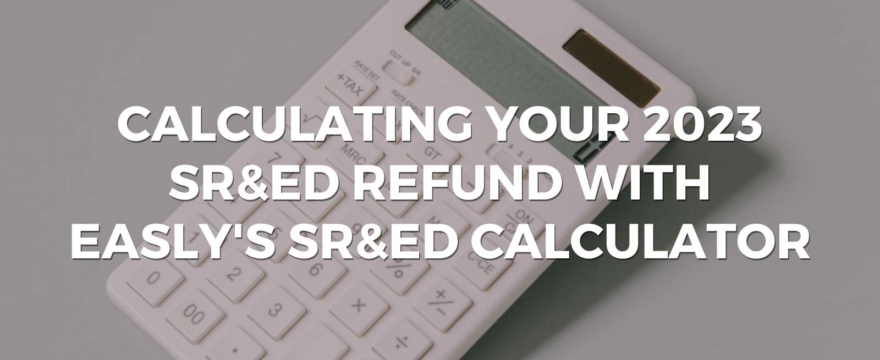
Do you know the size of refund your company is eligible for under the Scientific Research and Experimental Development (SR&ED) program? As Canada’s largest source of funding for research and development (R&D), SR&ED awards eligible businesses significant tax credits each year, with over $4 billion granted to claimants in 2021 alone. The intent of the program is to incentivize and support continued homegrown innovation and development across the country, and the amount of tax credits received depends on the assigned value of qualifying activities within a single calendar year.
Knowing how to properly document and calculate expenditures and eligible costs is essential to ensure you get the highest return possible and avoid a time-consuming audit. The cut-off for submitting a claim is 18 months after the end of your fiscal year. Below, we’ll take a quick look at one of the most straightforward ways you can calculate your refund and the benefits of partnering with a trusted Capital-as-a-Service provider like Easly. Read on to learn more!
How to Estimate Your SR&ED Refund
SR&ED credits are claimed by filing Form T661 to the CRA, with companies having up to 18 months after their fiscal year-end to submit their SR&ED claim. Once a claim is accepted and approved, it can take weeks or even months to receive your refund.
It is also worth noting that each SR&ED claim is evaluated on an annual basis, meaning that you shouldn’t wait until your project is fully complete (see other SR&ED myths here) to apply. As long as you have a qualifying project and ample supporting documentation, claiming SR&ED is a viable option for businesses nationwide.
Before you claim SR&ED credits, you will need to assess the following variables for your application:
Salaries
Under SR&ED guidelines, there are four main classifications that qualify for tax refunds:
- Basic research
- Applied research
- Experimental Development
- Supporting activities that directly influence all aspects of your research and development
Vital expenditures like payroll, materials, and sub-contracts all play a key role in your research and are thus eligible to claim for qualified SR&ED projects. When compiling your payroll expenses, you’ll want to focus on how many hours each team member is involved in qualifying activities daily, then multiply the total hours by hourly pay rates. In the case of salaried employees, divide the annual wage by hours worked during that year for the balance amount to be claimed. Additionally, overhead costs to support those workers are also eligible for SR&ED. Most claimants use the “proxy method” to determine the eligible overhead expenses, which grants an additional 55% on top of eligible salaries.
Total Contractor Expenses
When claiming contractor expenses, it’s important to note that any individuals or firms (both are applicable) must be Canadian to be eligible. If your contractors don’t have a SIN or HST/BN number, their cost will not be eligible for claiming SR&ED. Under SR&ED guidelines, contractor expenses are available for up to an 80% refund of the total cost, and this is the number that should be submitted with your application.
Material Costs
When claiming your material expenses, it’s vital to know what does and doesn’t qualify for SR&ED credit. Under program parameters, you may claim materials that are consumed or rendered valueless in SR&ED-eligible projects, as well as the cost of shipping said materials, including customs and duties. Once you have a comprehensive list of materials and a totalled amount, you can submit them as part of your SR&ED claim for the year.
R&D Headquarters Location
Many regions in Canada offer an additional R&D tax credit along with the federal SR&ED program. The percentage of eligible expenses awarded credits various across the provinces and territories. Make sure you know the provincial or territorial parameters for claiming the non-federal portion of SR&ED.
Expenditure Limit
To make sure you are submitting your claim properly, you may want to work with a consultant to determine your SR&ED expenditure limit with accuracy. For a more detailed guide on the SR&ED expenditure limit, read our previous blog here.
Using an SR&ED Calculator
Need help crunching numbers to get a good estimate of the size of your SR&ED refund? We’ve got you covered! Our SR&ED refund calculator eliminates much of the confusion faced by first-time and even veteran filers, as parameters occasionally change. Our calculator provides a quick estimate of your projected refund and allows you to move forward with confidence.
Finance Your SR&ED Tax Credits with Easly
Overcoming the waiting period between SR&ED expenditures and payout presents a unique challenge for R&D-focused companies across Canada. Partnering with a Capital as a Service (CaaS) firm like Easly eliminates the stress of long waits and makes it easy for your company to access necessary funding as soon as possible. Once you’ve had the chance to determine your projected refund using our SR&ED Refund Calculator, try out our Easly Cash Flow Calculator and see the potential cash flow you could start receiving from Easly in as little as two weeks.
Contact us today for more information on how you can turn your distant SR&ED refund into cash on your balance sheet!
.png)
.png)
.png)
